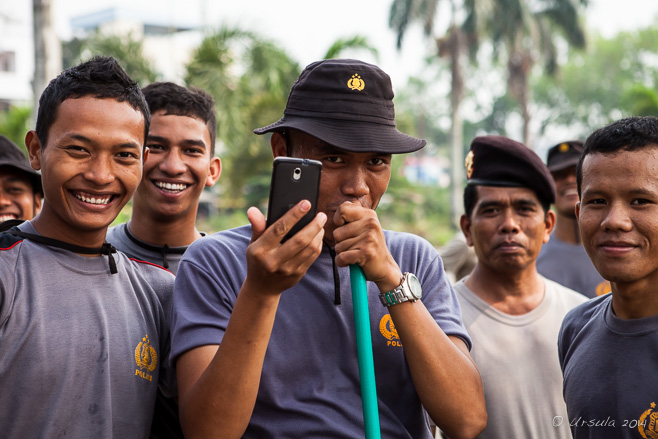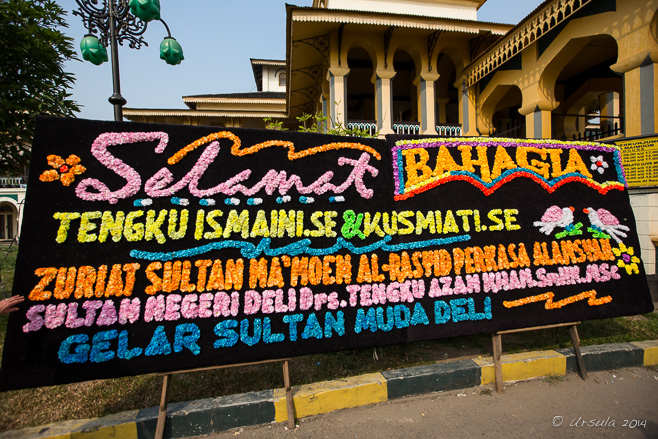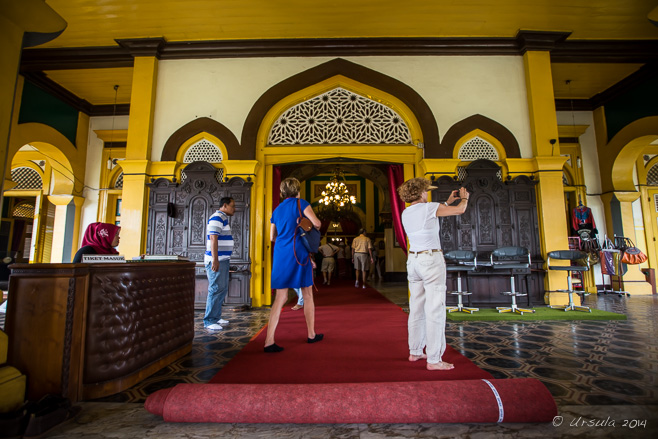
Polisi
Indonesian policemen on clean-up duty at Maimoon Palace, Medan, North Sumatra, take the opportunity to photograph me.
It is only a short hop from Singapore to Indonesia by boat or plane, but it may as well be a whole world away (q.v. From Resort to Reality).
Last month, after a week in the ultra-modern high-rise city-state of Singapore (Magical Flying Machines and Gardens by the Bay), my husband and I took a side-trip to Sumatra, Indonesia’s largest island. The flight from Singapore’s Changi Airport to Medan takes just over an hour. As soon as we walked out of the brand-new Kualanamu International Airport, however, there was no doubt that we had arrived in a different country: old Dutch colonial buildings rubbed shoulders with Moghul architecture; decrepit vehicles crowded the dirty, littered streets; political posters and billboards competed for attention; and the heat, dust and smells tried to work their way into our vehicle. According to Lonely Planet, Medan regularly comes up in response to: ‘What’s the worst place you’ve ever visited?’
But for all this, after the high-octane buzz of the somewhat-sterile Singapore, I found North Sumatra markedly more relaxed. Instead of rushing around, staring at or talking into their phones, people actually looked at us – and smiled. They took the time to chat and have their pictures taken. Except for the chaotic traffic, everything was slower.
It is, indeed, a very different place.

“Selamat Bahagia”
Colourful billboards sponsored by local businesses offer their “Congratulations” to selected newlyweds in Medan.

Maimoon Palace
Tourists on the red carpet outside Maimoon Palace, Medan.

Shoes on the Marble
Nothing says “Asia” more clearly than a pile of shoes outside a public building.

Podium of the Sultan
Maimoon Palace was built in 1888 by Sultan Ma’mun Al Rasyid Perkasa Alamsyah, who ruled Medan from 1873 to 1924 – thanks to his good relations with the Dutch who were expanding their tobacco trade in the area.

Outer Pavilion
There is half a cannon housed inside the pavilion that sits in the palace grounds. The story is that the very beautiful Princess of Deli Tua rejected a marriage proposal from the King of Aceh to the north. The King was so angry he invaded and was about to win the war, until one of the princess’ brothers turned himself into a cannon, shooting out wildly, and preventing the King’s troops from capturing her.

Children in Traditional Dress
There is a wardrobe booth inside Maimoon Palace, and you can dress up as a Dato’ (Sultan) or a Princess, and then have your picture taken inside the buildings. Costumed by their parents, these children posed happily for me as well.

Interior
The palace architecture is a mixture of cultures and styles. The predominant colour is yellow, a Malay favourite, and the design blends European, Islam, Spanish, Indian, and Italian elements.

Police Clean-Up
Maimoon Palace is still used for special events. The local police are enlisted as security and clean-up detail.

Police Crew
Seeing me with my cameras, the clean-up crew spontaneously came together for a group photo.

Dutch Influence
Dutch colonialists were significant in developing the area from the 1860s, and the buildings in Medan reflect this.

Tjong A Fie Mansion
Completed in 1900, the Chinese-European, art-deco style mansion built by Tjong A Fie (1860-1921), a prominent Hakka merchant who owned much of the land around Medan, is a distinctive contrast to the other buildings around it.

Field Post Office
The post office in the middle of Medan, completed in 1911, is another example of Dutch colonial architecture.

Becak 3-Wheeled Taxi Cab
In the square outside the post office, becak drivers wait for customers…

Parking Warden
… while officers monitor the parking in the area.

Australian Troops
Tip Top Restaurant (and its menu) traces back to Dutch colonisation. As I drank my locally-grown coffee in what was once, reputedly, “THE restaurant in Medan”, I was taken by the historic photograph of Allied troops marching through the Medan streets in 1947.

Open-Plan Kitchen
Well west of Medan, we stop for lunch, which is cooked in a hot, dark kitchen, over open flames.

Turangie Palm Plantation
Since 2009, Indonesia has been the world’s largest producer of palm oil, giving the country’s economy a much-needed boost, but contributing to social and environmental problems…

Oil Palm
… including de-forestation, soil and habitat degradation …

Turangie Palm Oil Mill
… and polluting smoke from the processing plants.

Rubber Trees
Of course, rubber plantations are just as damaging to the soil. Indonesia is the world’s second largest natural rubber exporter.

Girl in Purple
In the rubber plantations, we met a young girl, whose father is British …

Mother and Son
… and her best friend, whose father is German. The friend’s mother described her work tapping the rubber trees.

Bridge to the Eco Lodge
At Bukit Lawang, a suspension bridge leads us over the Bahorok River to our accommodation.
 Perhaps it is fitting that, in this “other world”, we had a dip-bucket rather than a shower, and we had no hot water in our open-air bathroom…
Perhaps it is fitting that, in this “other world”, we had a dip-bucket rather than a shower, and we had no hot water in our open-air bathroom…
Never mind! We had a national park next door: home to the few remaining Sumatran orangutans, whom we planned to visit the next day – showered or not!
Till then, Keep Smiling!
Pictures: 15February2014


























.jpg)


[…] As soon as we walked out of the park boundaries, we were back in the rubber plantations, much like those we’d seen, mile after mile, on the drive from Medan the day before. […]
[…] It was hard to leave the Gunung Leuser National Park, but our itinerary called for us to move on. And, much of the overall impression of any trip comes from the smaller things: the insights into day-to-day life, the “ordinary” landscapes, and the people you meet along the way, as you travel from one place to another (q.v. Ursula’s Weekly Wanders: Medan to Bukit Lawang). […]